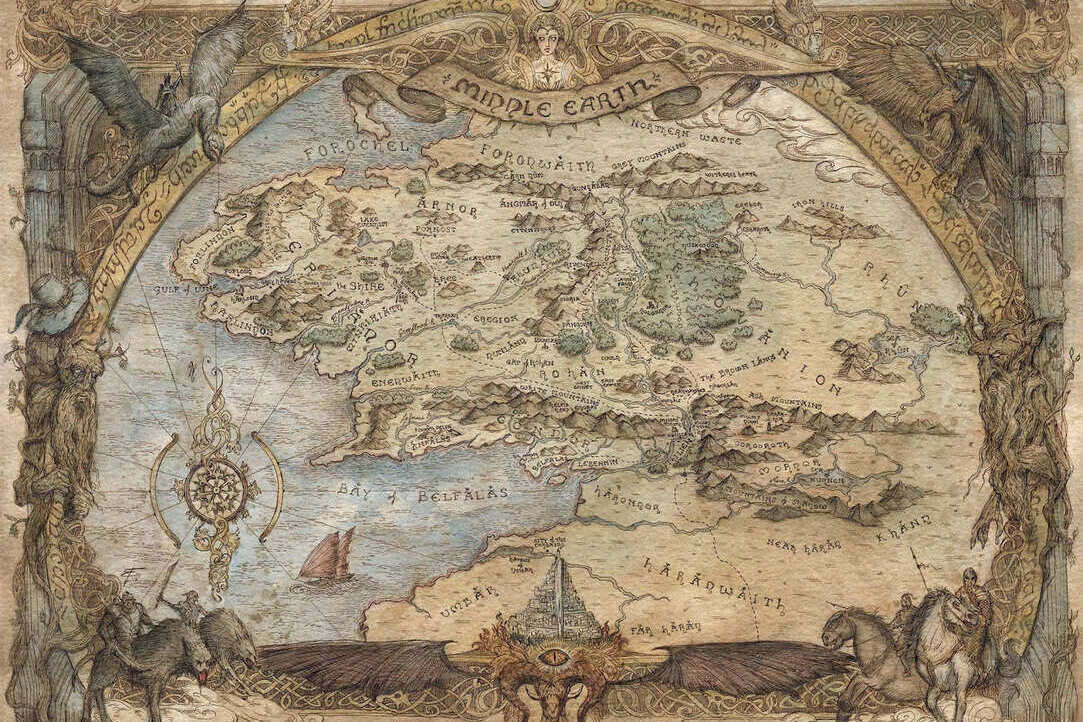The Whole Picture or ‘The Atlas of Middle-Earth’

“The wide world is all about you: you can fence yourselves in,
but you cannot for ever fence it out.”
J.R.R. Tolkien
We have covered so many topics and enlisted so many sources of inspiration for Middle-earth that there’s nothing more to study except for scenery.
Tolkien’s literary creations are filled with numerous detailed descriptions of practically everything. For instance, just recall the beginning of the Hobbit and it will become clear as day for you how much Tolkien loved subtlety and attention to details:
“In a hole in the ground there lived a hobbit. Not a nasty, dirty, wet hole, filled with the ends of worms and an oozy smell, nor yet a dry, bare, sandy hole with nothing in it to sit down on or to eat: it was a hobbit-hole, and that means comfort.”
But it was the setting that had always been of particular value to him. J.R.R. was a big fan of sketching and drawing. He created illustrations for his own books, which subsequently served as benchmarks for other illustrators of these works and even Peter Jackson when filming the movie adaptations of Tolkien’s masterpieces.
According to the scholars and the author’s family, J.R.R. Tolkien was an extremely perceptive person with vivid fantasy that could store memories and images for decades. There are many elements in Tolkien’s writing that were inspired by his childhood and later experiences. The important fact that we’re approaching here is that Tolkien’s literary creations are based on a vast library of knowledge, pictures, stories, experiences, and emotions that he was collecting throughout his life.
Exciting things never escaped from his imagination and under his pen, whether they were too beautiful or too terrifying. And there were many places that left footprints on his mind at different stages of life. A big number of those locations ended up being thoroughly described in the flow of narration about Middle-earth and its protagonists (and antagonists, too). So, like true explorers we will step on the path where Tolkien once stood and follow him through the places that are now reflected and preserved on the pages of his literary creations.
J.R.R. Tolkien and his ‘There and Back Again’
Before looking at all the major locations of Middle-earth in particular, it is useful to learn about Tolkien’s tour in the Swiss Alps, which transpired in 1911. At the age of 19 young John Tolkien went on a hiking summer trip to Switzerland to discover, as it turned out years after, future inspiration for his fantasy realm. Later in his letters he confessed that this adventure played a crucial role both in his personal and writing life. Not only did locations echo in the world of Middle-earth but also the spirit of a risky yet fascinating journey with mutual purpose. It is believed that even the number of the participants in this trip equals the company from the Hobbit.
Shire
We will begin our journey in the manner of Tolkien – in Shire – this green land of calmness, conservatism, and hobbits. Tolkien spent most of his young years in and out of Birmingham and it was a perfect time for him to explore and steep in the amazing country landscapes of central England. The homeland of the small hairy creatures, who valued comfort over everything else, was based sufficiently on the English countryside of Warwickshire and the area around Sarehole Mill. Shire derived its rolling hills, lush meadows, and gentle rivers from these locations along with other picturesque places of English countryside.
Rivendell and Misty Mountains
The city of Rivendell, a refuge of Elves and Wizards, was based on the area of Lauterbrunnental in Switzerland. Its majestic beauty with high peaks, lush forests and mighty rivers was inspired by the stunning landscape of the Swiss Alps. Furthermore, as you have already guessed, the enigmatic and high ridge of Misty Mountains came to Tolkien as an association with the same geographical location.
Gondor
The white towers and majestic cliffs of the lonely city of Gondor were based on several different places. The first one, that carries the strongest resemblance, is the magnificent castle Mont-Saint-Michel in France. The interior of the city must have been drawn from Oxford itself – the place where Tolkien spent almost all of his conscious life. And thirdly, as John Garth, a famous writer and Tolkien’s biographer, said ‘He (Tolkien) just used whatever was convenient to him’, addressing the matter of inspiration for Gondor and pointing out the likeness between the White City of Men and a fragment from Sandro Botticelli’s interpretation of Alighieri's Divine Comedy. Not a real-life location, but definitely worth mentioning.
Mordor and the Dead Marshes
The terrifying realm of Mordor, home to the Dark Lord Sauron, was based on the volcanic mountains of Iceland. Its barren landscape and dark fortresses were inspired by the desolate terrain of the country’s volcanic regions.
But the whole image of the evil that occupied those grounds was awakened in Tolkien’s traumatic memories about WWI. The Dead Marshes are a direct reflection of the area around the river Somme during the bloody battle.
Lothlórien
The towering trees, hidden glades, and mysterious rivers of the majestic forests of Lothlórien, the grounds of the Elves, were inspired by the dense woodlands of the Ardennes in Belgium – a vast wilderness of ancient oaks and beech trees. Yet, this fantasy location can be a collective image, indeed. Tolkien was just too fond of forests to include only one into the Elven realm. So, consider Lothlórien to be a child of all the Tolkien’s forests.
Moria
The caves and tunnels of the Yorkshire Dales in England served as a base for the underground kingdom of Moria, the ancient stronghold of the Dwarves. Its broad caverns, deep chasms and mysterious passageways were derived from the mysterious depths of the Dales and the labyrinths of Yorkshire.
Locations of Middle-earth and innumerable as well as those of our reality. No one can tell exactly what ingredients and doses were used by Tolkien in the recipe of his Secondary World. But, at least, we can endeavour to restore the world he created bit by bit and discover more new aspects every time.
From the rolling hills of the Shire to the dark depths of Moria, each location of Middle-earth has its own unique beauty and mystery, shaped by the landscapes and cultures of our own world.
It appears that we have reached the final point of this course. There’s only one more thing that we are to enclose:
In article two we posed a provocative yet necessary question:
Why would such an extraordinary writer as John R.R.Tolkien use so many borrowings?
Let us quickly brush through everything that we have learnt about J.R.R. Tolkien, his life and personality, and the answer will come bright as a day. John Ronald Reuel Tolkien lived a life of adventure and absorbed it as much as he only could. He was a world's citizen, a time traveller, and a lover of the reality he existed in. He loved it so dearly that collected all the possible information from all corners of this universe and placed them into a realm of his own.
J.R.R. Tolkien was simply too fascinated by our, by his world to cut its roots from his literary masterpieces.
Yours truly,
Karima Lakekhal
References
- Garth J. The Worlds of JRR Tolkien: The Places that Inspired Middle-earth. – Princeton University Press, 2020.
- Monsch M.S. Switzerland in Tolkien's Middle-Earth: In the footsteps of his adventurous summer journey in 1911—with hiking suggestions. – Martin S. Monsch, 2021.
- The Real Places That J. R. R. Tolkien Got His Inspirations For Middle-Earth From // YouTube
- Bunting N., Currie E. Tolkien’s Fantasy Landscape // Mallorn: The Journal of the Tolkien Society. – 2020. – №. 61. – С. 6-14.
- Fonstad K.W. The atlas of Tolkien’s Middle-earth. London, England: HarperCollins, 2017.


